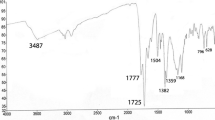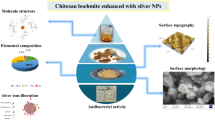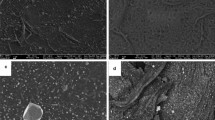Abstract
In this project, pseudo-poly(amino acid)s (PAAs) containing different amino acids in main chain were synthesized by direct polyesterification of N,N-(pyromellitoyl)-bis-D-4-hydroxyphenylglycine dimethyl ester as biologically active diol with diacid monomer derived from different amino acids was carried by tosyl chloride/pyridine/N,N′-dimethylformamide as a condensing agent. All biological properties of the polymers were determined by biological evaluation in bacterial media. PAAs containing silver nanoparticles were fabricated by in situ method using dimethylformaide (DMF) as a solvent which leads to a spontaneous reduce in room temperature. Furthermore, these biopolymer nanocomposite/Ag thin films were immobilized on glass microbeads. The chemical structures of synthesized PAAs and PAA/Ag nanocomposite (NC) were considered by FTIR, 1H-NMR spectroscopy, transmission electron microscopy (TEM), elemental analysis, differential scanning calorimetry (DSC), thermogravimetric analysis (TGA), scanning electron microscopy, and energy dispersive X-ray (EDAX). The results of EDAX and TEM analysis of PAAs/Ag NC showed that silver particles have homogeneous dispersion and uniformity in nano-dimensions about 50 nm in PAAs matrix. The micro glass beads were coated with PAA/Ag nanocomposite thin film and placed in a column through for the disinfecting effect of Escherichia coli in water was evaluated very well.















Similar content being viewed by others
References
Vikesland P (2018) Nanosensors for water quality monitoring. Nat Nanotechnol 13:651–660
Jain P, Pradeep T (2005) Potential of silver nanoparticle-coated polyurethane foam as an antibacterial water filter. Biotechnol Bioeng 90:59–63
Motshekg SC, Ray SS, Maity A (2018) Synthesis and characterization of alginate beads encapsulated zinc oxide nanoparticles for bacteria disinfection in water. J Colloid Interface Sci 512:686–692
Park S, Ko YS, Jung H, Lee C, Woo K, Ko G (2018) Disinfection of waterborne viruses using silver nanoparticle-decorated silica hybrid composites in water environments. Sci Total Environ 625:477–485
Yoon KY, Byeon JH, Park JH, Hwang J (2007) Susceptibility constants of Escherichia coli and Bacillus subtilis to silver and copper nanoparticles. Sci Total Environ 373:572–575
Zhang L, Ding Y, Povey M, York D (2008) ZnO nanofuids-a potential antibacterial agent. Prog Nat Sci 18:939–944
Salmani MH, Mirhosseini M, Moshtagi laregani M and Akrami Ch, (2017) Survey of silver nanoparticles antibacterial activity against gram-positive and gram-negative bacteria in vitro. J Tolooebehdasht Sci 15(1):76–84
Ghasemzadeh H, Ghanaat F (2014) Antimicrobial alginate/PVA silver nanocomposite hydrogel synthesis and characterization. J Polym Res 21(3):1–14
Pokhrel LR, Dubey B, Scheuerman PR (2014) Natural water chemistry (dissolved organic carbon pH and hardness) modulates colloidal stability dissolution and antimicrobial activity of citrate functionalized silver nanoparticles. Environ Sci Nano 1(1):45–54
Liu Y, Liu X, Wang X, Yang J, Yang X-J, Lu L (2010) Gelatin-g-poly(methyl methacrylate)/silver nanoparticle hybrid films and the evaluation of their antibacterial activity. J Appl Polym Sci 116:2617–2625
Eid M, El-Arnaouty MB, Salah M, Soliman E-S, Hegazy E-S (2012) Radiation synthesis and characterization of poly (vinyl alcohol)/poly (N-vinyl-2-pyrrolidone) based hydrogels containing silver nanoparticles. J Polym Res 19(3):1–10
Abdel-Mohsen AM, Aly AS, Hrdina R, El-Aref A (2012) A novel method for the preparation of silver/chitosan-O-methoxy polyethylene glycol core shell nanoparticles. J Polym Environ 20(2):459–468
Correa CM, Faez R, Bizeto MA, Camilo FF (2012) One-pot synthesis of a polyaniline–silver nanocomposite prepared in ionic liquid. RSC Adv 2(7):3088–3093
Hebeish A, Hashem M, El-Hady MMA, Sharaf S (2013) Development of CMC hydrogels loaded with silver nano-particles for medical applications. Carbohydr Polym 92(1):407–413
Mallakpour S, Dehghani M, Sabzalian M (2013) Green step-grow polymerization of biodegradable amino acid based diacids with 3, 5-diamino-N-(thiazole-2-yl) benzamide: characterization and study on bioactivity. J Polym Res 20(2):85–90
Armentano I, Dottori M, Fortunati E, Mattioli S, Kenny JM (2010) Biodegradable polymer matrix nanocomposites for tissue engineering: A review. Polym Degrad Stab 95:2126–2146
Mallakpour S, Banihassan K, Sabzalian MR (2013) Novel bioactive chiral poly(amide–imide)s containing different amino acids linkages: studies on synthesis characterization and biodegradability. J Polym Environ 21(2):568–574
Rafiei HR, Shirvani M, Ogunseitan OA (2016) Removal of lead from aqueous solutions by a poly (acrylic acid)/bentonite nanocomposite. Appl Water Sci 6(4):331–338
Undabeytia T, Posada R, Nir S, Galindo I, Laiz L, Saiz-Jimenez C, Morillo E (2014) Removal of waterborne microorganisms by filtration using clay-polymer complexes. J Hazard Mater 279:190–196
Motshekga SC, Sinha Ray S (2017) Highly efficient inactivation of bacteria found in drinking water using chitosan-bentonite composites: modelling and breakthrough curve. Water Res 111:213–223
Hokkanen S, Bhatnagar A, Sillanp M (2016) A review on modification methods to cellulose-based adsorbents to improve adsorption capacity. Water Res 91:156–173
Algothmi WM, Bandaru NM, Yu Y, Shapter JG, Ellis AV (2013) Alginate-graphene oxide hybrid gel beads: an efficient copper adsorbent material. J Colloid Interf Sci 397:32–38
Mokhena TC, Luyt AS (2017) Electrospun alginate nanofibers impregnated with silver nanoparticles: preparation morphology and antibacterial properties. Carbohyd Poly 165:304–312
Seyedjamali H, Pirisedigh A (2011) In situ sol–gel fabrication of new poly(amide–ether–imide)/titania (TiO2) nanocomposite thin films containing L-leucine moieties. Colloid Polym Sci 289:15–20
Mallakpour S, Tirgir F, Sabzalian MR (2011) Synthesis, characterization and in vitro antimicrobial and biodegradability study of pseudo-poly(aminoacid)s derived from N, N-(pyromellitoyl)-bis-L-tyrosine dimethyl ester as a chiral bioactive diphenolic monomer. Amino Acids 40:611–621
Mallakpour S, Dinar M (2013) Reinforcement of poly(vinyl alcohol) with chiral poly(amide-imide)s nanoparticles containing S-valine under simple ultrasonic irradiation method. Colloid Polym Sci 291:2487–2494
Mallakpour S, Dinar M (2012) Chiral poly(amide-imide)/organoclay nanocomposites derived from pyromellitoyl-bis-l-isoleucine and benzimidazole containing diamine: synthesis nanostructure and properties. Colloid Polym Sci 290:81–90
Mallakpour S, Dinar M (2013) Straightforward and green method for the synthesis of nanostructure poly(amide-imide)s-containing benzimidazole and amino acid moieties by microwave irradiation. Polym Bull 70:1049–1064
Mallakpour S, Dinar M (2014) Anionic clay intercalated by multi-walled carbon nanotubes as an efficient 3D nanofiller for the preparation of high-performance l-alanine amino acid containing poly(amide-imide) nanocomposites. J Mater Sci 49:7004–7013
Mallakpour S, Amir A, Borandeh S, Sabzalian MR (2015) One pot fabrication of optically active and efficient antibacterial poly(amide-benzimidazole-imide)/Ag bionanocomposite. J Polym Res 22:129–131
Mallakpour S, Hatami M (2018) Green and eco-friendly route for the synthesis of Ag@Vitamin B9-LDH hybrid and its chitosan nanocomposites: characterization and antibacterial activity. Polymer 154:188–199
Mallakpour S, Ramezanzade V (2020) Green fabrication of chitosan/tragacanth gum bionanocomposite films having TiO2@Ag hybrid for bioactivity and antibacterial applications. Int J Biol Macromol 162:512–522
Tirgir F, Sabzalianc MR, Moghadam G (2015) Fabrication and DFT structure calculations of novel biodegredable diphenolic monomer containing D-4-hydroxyphenylglycine moiety as biologically active substituent: compression with toxic industrial bisphenol-A. Des Monomers Polym 18(5):401–412
Kufelnicki A, Wozniczka M, Kalinowska-Lis U, Jezierska J, Ochocki J (2013) Synthesis, acid–base and complexing properties with Cu(II) Co(II) and Zn(II) in aqueous solution of a novel 1H-benzimidazol-2-ylmethyl diethyl phosphate ligand: comparison with other 2-substituted benzimidazole ligands. Polyhedron 53:20–25
Yeasmin D, Jahan Swarna R, Nasrin MS, Parvez S, Alam MF (2016) Chrysanthemum morifolium Ramat Against multi-drug resistant human pathogenic bacteria. Int J Biosci 78–87
Andrews JM (2001) Determination of minimum inhibitory concentration. J Antimicrob Chemother 48:5–16
Anderson JM, Gibbons DF, Martin RL, Hiltner A, Woods R (1974) Prostheses and tissue: the interface problem. Wiley, New York
Pastoriza-Santos I, Liz-Marzán LM (2009) N, N-Dimethylformamide as a reaction medium for metal nanoparticle synthesis. Adv Funct Mater 19(5):679–688
Singh N, Khanna PK (2007) In situ synthesis of silver nano-particles in polymethylmethacrylate. Mater Chem Phys 104(2–3):367–372
Acknowledgements
We wish to express our gratitude to the Research Affairs Division, Islamic Azad University, Shahrekord Branch, for slight financial support.
Author information
Authors and Affiliations
Corresponding author
Ethics declarations
Conflict of interest
The authors declare no competing interests.
Additional information
Publisher's Note
Springer Nature remains neutral with regard to jurisdictional claims in published maps and institutional affiliations.
Rights and permissions
About this article
Cite this article
Ghorbani, F., Tirgir, F. & Jafari, A. Construction and characterization of the novel polymer/Ag nanocomposite coated on glass bead as filter for inactivation of E. coli in water. Colloid Polym Sci 299, 1917–1932 (2021). https://doi.org/10.1007/s00396-021-04899-2
Received:
Revised:
Accepted:
Published:
Issue Date:
DOI: https://doi.org/10.1007/s00396-021-04899-2




